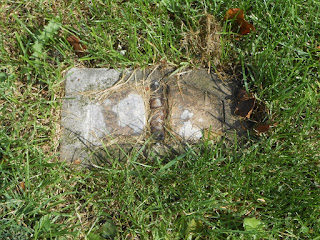
This odd little investigation began with a post last week in which I asked for information about a gentleman named Frank Davis, 1896-1978, apparently buried beneath a funeral home marker just south of the Copeland mausoleum (left) in the western part of the Chariton Cemetery.
I was interested in finding out who the gentleman was --- a brief notice in The Herald-Patriot provided no information other than the fact he had lived for some years at the McCollum Nursing Home, operated by the McCollum family on South Main Street until 1979. Beyond that, the Korean War flag holder at the grave didn't seem like a good match for someone who would have been 50 years old when World War II ended.
Then I discovered that there are four men named Frank Davis among the 13,000-plus burials in the cemetery and that there seemed to be a bit of confusion about where two of them were buried.
+++
Avis Goben, at Chariton City Hall, helped me sort out the first part of the puzzle during a visit to the room where cemetery records are maintained.
As it turns out that funeral home marker does not belong to the Frank Davis buried underneath it. The lot itself remains Copeland family property, purchased when the mausoleum was built on lots to the north in 1913.
Frank Crowley Davis, born March 8, 1932, in Dallas, Texas, died Aug. 8, 1982, at Ottumwa, actually is buried here. This Frank was the husband of Sue Holman Davis, daughter of Dr. David and Harriett (Copeland) Holman, granddaughter of Howard Custer and Edith (Larimer) Copeland, and great-granddaughter of Howard Darlington and Carrie (Custer) Copeland, for whom the mausoleum was built. All but one of the latter (Edith) are interred in the mausoleum. Edith is buried nearby with her parents. Were it not for this mistakenly placed metal marker, Frank Crowley Davis's grave would be unmarked.
I'm guessing that the Korean War flag holder is intended for Frank Crowley Davis. The Frank Davis commemorated on the metal marker does not appear to have been a veteran, although he certainly may have been --- but most likely not of Korea.
+++
Lester McCollum clarified the puzzle further. Both his father, Lester J. McCollum (1931-1980), and grandfather, Lester C. McCollum (1908-1990), were involved in nursing home operations
Lester actually remembered Frank Davis as a man of few words who was placed with several others in the family nursing home by what then was the Iowa Mental Health Institute at Mount Pleasant. These were men who needed custodial but not institutional care and were placed as part of a program based on the philosophy that, as wards of the state, they would receive better individualized physical and social care in private custodial care settings.
Five of these men, including Frank, are buried in a row near Highway 14 at the eastern boundary of the cemetery. You can see in the photo at the top the gap in the sequence of small stones where Frank is buried and where his marker should be.
The men are William R. Owens, 1894-1969; H. Bruno Seifert, 1898-1970; Albert Olson, 1911-1974; Frank Davis, 1896-1978; and Clyde M. Dicks, 1898-1979.
I wasn't able to track down information about Mr. Owens or Mr. Olson, but census records show that Mr. Seifert had been a resident of what then was the Mt. Pleasant State Hospital for the Insane since at least 1930, when he was 31. Mr. Dicks appears first in 1940 census reports for the hospital, when he was 42.
The men, as wards of the state, would have been buried at public expense and cemetery records show that Fielding Funeral Home purchased the individual plots where each is buried at the time of their deaths. Lester McCollum remembers that his grandfather insisted that the graves be marked and purchased himself the small tombstones that mark four of the five graves and probably arranged to have a metal funeral home marker turned into a permanent marker for Frank Davis, too. It was embedded professionally in concrete.
+++
So what happened? Here's my best guess. If you look at the Frank Davis grave you'll see that the funeral home marker no longer is embedded in its concrete base. Most likely, it popped out or perhaps was damaged by a lawn mower and removed some years after it was placed.
Some good-hearted soul then set out to either repair the marker and mounted it on a new stake or, alternatively, acquired an entirely new funeral home marker for Mr. Davis.
It then was placed at the grave of the wrong Frank Davis by someone who did not realize that there were two unmarked Frank Davis graves in the cemetery at the time and did not check cemetery records to make sure that the dates on the marker conformed to the dates of birth and death of the man beneath it.
I'm not quite sure what the solution is here. Perhaps to obtain a new funeral home marker for Frank Crowley Davis and only then return the marker now at his grave to its rightful owner.



No comments:
Post a Comment